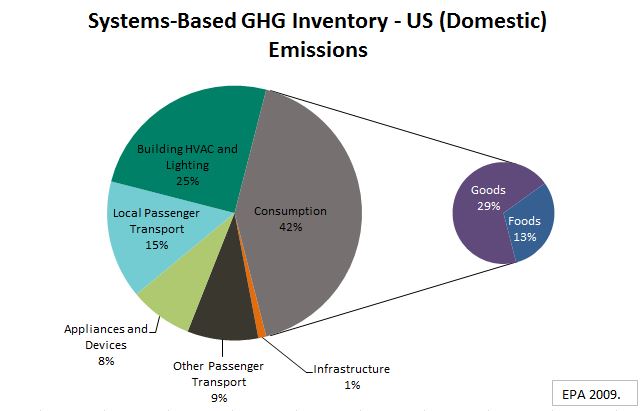June 7, 2016
Everyone has stuff. I try to limit the amount of mine, but I’ll admit I love my home entertainment center and my iPad; and then there’s the car, household furniture, appliances etc. And we all have to eat. According to EPA, more than 40% of the climate impact in our country comes from our stuff and our food. That is, how we make it, haul it, use it, and discard it. These are our “consumption-based emissions.”
The Organization for Economic Co-operation and Development (OECD) says we’re number two in the rankings for both total consumption-based emissions and production-based emissions. China ranks number one.
In our current capitalistic global economy, we are encouraged to produce, buy, and consume for economic growth, so consumption-based emissions go hand in hand with our linear economy. The more we buy and discard, the more energy and resources it takes to make new stuff and produce more food, and the more pollution and greenhouse gas (GHG) emissions we generate. As developing nations prosper they naturally strive to produce, consume, and discard the way that we have in North American and European countries.
What’s the primary measure of a country’s economic health? GDP of course—Gross Domestic Product—the monetary value of all the finished goods and services produced within a country's borders in a specific time period.
Until—and if—we adopt a circular economy, it’s up to each of us to take responsibility for at least slowing down the rate of our emissions. Buying durable, reusable products is one way to have an impact. Purchasing less stuff is another. Then there’s the waste component.
Zero Waste is a concept that many of us in our business have been slow to embrace. To me, it embodies an attainable goal. Can we get there in our current economy? No. Will we be there in the near future? No. But does that mean we shouldn’t at least strive for the best we can in our existing situation? I advocate yes. I believe it’s important to promote it and keep talking about it. Zero Waste addresses the entire system of production and consumption. Striving for it points us in the right direction for reducing climate emissions by “changing what and how much we buy, what resources went into making it, how long it’s designed to last, how much gets reused, recycled or composted, and what we throw away.”
 In a Guest Blog article written by Kate Bailey, Program Manager for Eco-Cycle Solutions last year, 10 Reasons Why Zero Waste Is a Priority Climate Solution, she outlined the benefits of striving for Zero Waste.
In a Guest Blog article written by Kate Bailey, Program Manager for Eco-Cycle Solutions last year, 10 Reasons Why Zero Waste Is a Priority Climate Solution, she outlined the benefits of striving for Zero Waste.
If you need to know where to start on adopting and promoting Zero Waste here are some recent resources from Eco-Cycle Solutions:
- Zero Waste Climate Solution video is a great introduction to how recycling and composting are two of the fastest, most cost-effective solutions for reducing climate change.Watch the video >
- New executive summary of Eco-Cycle Solutions’ Community Zero Waste Roadmap where local leaders lay out a vision for a Zero Waste future. Get the plan >
- And, with the summer events season upon us, Eco-Cycle Solutions has compiled a top 5 list of communities that require recycling at events, and tools to help you create a Zero Waste event: from a backyard BBQ to a multi-day festival. See the blog post and get moving on Zero Waste events >. Also check out NERC’s Special Event Food Waste Diversion Guide.
I’m fond of saying my dog is “always hopeful.” I myself tend toward the cynical side of things. Nonetheless, goals are good and striving for Zero Waste is certainly a laudable one.
By Athena Lee Bradley


Comments (0)
Add a Comment